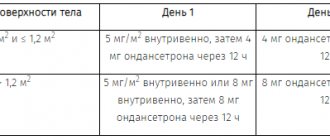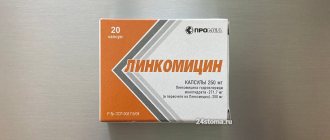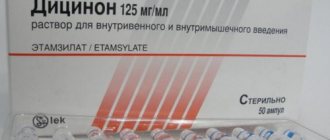Pharmacological properties of the drug Ceftazidime
Semi-synthetic β-lactam antibiotic from the group of third generation cephalosporins. It has a wide spectrum of action and is intended for parenteral use. It acts bactericidal, inhibiting the activity of microbial enzymes responsible for the synthesis of bacterial cell membranes. Resistant to β-lactamases. Ceftazidime is active both in vitro and in vivo against the following microorganisms: - gram-negative, including Pseudomonas spp . (including Pseudomonas aeruginosa ), Klebsiella spp . (including Klebsiella pneumoniae ), Proteus mirabilis, Proteus vulgaris, Escherichia coli, Enterobacter spp. (including Enterobacter cloacae and Enterobacter aerogenes ), Citrobacter spp . (including Citrobacter freundii and Citrobacter diversus ), Serratia spp., Haemophilus influenzae (including ampicillin-resistant strains) and Neisseria meningitidis ; - gram-positive, including Staphylococcus aureus, Streptococcus pyogenes A β-hemolytic streptococci ), Streptococcus agalactiae B streptococci ) and Streptococcus pneumoniae ; — anaerobic, including Bacteroides spp . (most strains of Bacteroides fragilis are resistant). The rate of elimination of ceftazidime is directly proportional to the administered dose. With intravenous administration, the half-life is about 1.9 hours, with intramuscular administration - about 2 hours. Less than 10% of ceftazidime binds to plasma proteins; this value does not depend on the concentration of the antibiotic. Not metabolized in the body, excreted mainly by the kidneys (80–90%) unchanged within 24 hours. Easily penetrates into organs and tissues of the body (including bone tissue), sputum, synovial, pleural, peritoneal fluids, tissues and eye fluid, through the placental barrier, poorly - through the intact BBB.
Side effects of the drug Ceftazidime
phlebitis at the site of intravenous injection (less than 2% of cases), allergic reactions (less than 2% of cases) - skin rash, itching, fever, extremely rarely - Quincke's edema, bronchospasm, arterial hypotension; disorders of the digestive tract (less than 2% of cases) - diarrhea, nausea, vomiting and abdominal pain, symptoms of pseudomembranous colitis, which may appear during or after completion of treatment; disorders of the central nervous system (less than 1% of cases) - headache, dizziness and paresthesia, epileptic seizures; the development of candidiasis (including candidal stomatitis and vaginitis) is possible. Laboratory tests revealed the appearance of eosinophilia, a positive Coombs test, thrombocytosis and a slight increase in the level of liver enzymes (ALAT, AST, LDH and alkaline phosphatase); rarely - transient leukopenia, neutropenia, agranulocytosis, thrombocytopenia and lymphocytosis.
Ceftazidim
The drug Ceftazidime is used only parenterally. The dose of the drug is set individually, taking into account the severity of the disease, the location of the infection and the sensitivity of the pathogen, age and body weight, and renal function.
After diluting the contents of the bottle, the drug is administered intramuscularly (should be injected into large muscles) or intravenously (stream or drip), 500 mg - 2 g every 8 - 12 hours. For most infections, a dose of 1 g every 8 hours or 2 hours is effective. g every 12 hours. In immunocompromised patients, including patients with neutropenia and severe disease, Ceftazidime should be prescribed 2 g every 8 or 12 hours.
Adults and teenagers
Complicated urinary tract infections
- IM or IV 0.5-1 g every 8-12 hours.
Uncomplicated pneumonia and skin infections
- IM or IV 0.5-1 g every 8 hours.
Cystic fibrosis, lung infections caused by Pseudomonas spp
. - from 100 to 150 mg / kg /, frequency of administration - 3 times / day (use of a dose of up to 9 g / in such patients did not cause complications).
Bone and joint infections -
IV 2 g every 12 hours.
For extremely severe or life-threatening infections
- IV 2 g every 8 hours.
After an initial loading dose of 1 g in adults with renal impairment (including patients undergoing dialysis)
Dose reduction may be necessary as follows:
| Creatinine clearance | Dose |
| > 50 ml/min (0.83 ml/sec) | usual doses for adults and adolescents |
| 35-50 ml/min (0.52-0.83 ml/sec) | 1 g every 12 hours |
| 16-30 ml/min (0.27-0.50 ml/sec) | 1 g every 24 hours |
| 6-15 ml/min (0.10-0.25 ml/sec) | 500 mg every 24 hours |
| < 5 ml/min (0.08 ml/sec) | 500 mg every 48 hours |
| Patients undergoing hemodialysis | 1 g after each hemodialysis session |
| Patients undergoing peritoneal dialysis | 500 mg every 24 hours |
These figures are indicative. In such patients, it is recommended to monitor serum drug levels, which should not exceed 40 mg/l.
T1/2 of the drug during hemodialysis is 3-5 hours. The appropriate dose of the drug should be repeated after each dialysis period.
With peritoneal dialysis
Ceftazidime can be included in the dialysis fluid at a dose of 125 mg to 250 mg per 2 liters of dialysis fluid.
Children
Children under 1 month of age
– IV infusion at a dose of 30 mg/kg/day (frequency of administration: 2).
Children aged 2 months to 12 years
– IV infusion at a dose of 30-50 mg/kg/day (introduction frequency 3).
For children
with reduced immunity, cystic fibrosis, or meningitis,
the drug is prescribed at a dose of up to 150 mg/kg/day every 12 hours.
The maximum daily dose for children should not exceed 6 g.
Rules for the preparation of solutions for parenteral administration
1. Primary breeding
| Dose | Volume of solvent for intramuscular administration | Volume of solvent for intravenous administration |
| 250 mg | 1.5 ml water for injection, 1% lidocaine hydrochloride solution (without epinephrine). | 5 ml water for injection |
| 500 mg | 1.5 ml water for injection | 5 ml water for injection |
| 1 g | 3 ml water for injection | 10 ml water for injection |
| 2 g | 3 ml water for injection | 10 ml water for injection |
2. Secondary dilution
For intravenous drip administration, the drug solution obtained as described above is additionally diluted in 50-100 ml of one of the following solvents intended for intravenous administration: 0.9% sodium chloride solution; Ringer's solution; lactated Ringer's solution; 5%, 10% glucose solution (dextrose); 5% glucose (dextrose) solution with 0.9% sodium chloride solution, 5% sodium bicarbonate solution.
During dilution, bottles with the drug must be shaken vigorously until their contents are completely dissolved.
Before administering the solution, you should visually ensure that there are no foreign particles or sediment and that the color of the drug for parenteral administration has not changed. The color of solutions can vary from light yellow to amber, depending on the solvent and volume.
Use only freshly prepared solution!
Ceftazidime overdose, symptoms and treatment
Manifested by pain, inflammation and phlebitis at the injection site. A significant overdose of cephalosporins can cause dizziness, paresthesia and headache. As a result of an overdose of some cephalosporins, epileptic seizures may occur, especially in patients with kidney pathology, which increases the likelihood of antibiotic accumulation. There may be an increase in the concentration of creatinine in the blood, urea, liver enzymes and bilirubin, as well as a positive Coombs test, thrombocytosis, thrombocytopenia, eosinophilia, leukopenia and an increase in prothrombin time. Treatment - in case of epileptic seizures, the antibiotic should be immediately discontinued and, if indicated, anticonvulsants should be prescribed. It is necessary to ensure monitoring of indicators of water-electrolyte and gas exchange; according to indications, carry out measures aimed at maintaining the ventilation-perfusion ratio. In cases of severe overdose, especially in patients with renal failure and when conservative therapy is ineffective, hemodialysis in combination with hemoperfusion is possible, but there is no data on the effectiveness of such therapy.
List of pharmacies where you can buy Ceftazidime:
- Moscow
- Saint Petersburg
Drug interactions Ceftazidime
Solutions of ceftazidime, like most β-lactam antibiotics, should not be added to solutions of aminoglycosides due to the possibility of their interaction; if simultaneous antibiotic treatment is necessary, the injection site should be changed. A nephrotoxic effect is observed after simultaneous administration of cephalosporins with aminoglycosides or with powerful diuretics (furosemide). The potential nephrotoxicity and ototoxicity of aminoglycosides should be considered, especially when administered in high doses or prolonged treatment.


